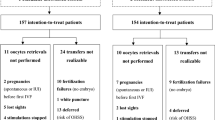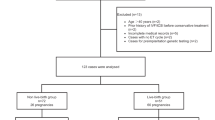Abstract
Purpose
Endometrial scratching (ES) using a biopsy catheter prior to the IVF cycle in the repeated implantation failure (RIF) population has been suggested, but no convincing evidence of its benefit has been presented until now.
Methods
A retrospective mono-center study among 300 consecutive IVF-RIF cycles following evaluation of the ovarian reserve, hysterosalpingography or hysteroscopy, pelvic ultrasound, thrombophilia evaluation, karyotyping and assessment of male sperm parametrs. The findings within normal limits. All the patients offered ES, 78 consented and underwent ES prior to their next IVF cycle.
Results
A comparison of treatment outcomes between the post-ES cycles (n = 78) and the non-ES cycles (222) demonstrated the following: 34 (43.5%) versus 14 (6.3%) conceptions, respectively (p = 0.001) and 30 (38.4%) versus 2 (0.9%) clinical pregnancies, respectively (p < 0.001%), emphasizing an extremely high biochemical pregnancy rate among the non-ES cycles. Implantation rate was 19.7% versus 0.4%, respectively (p < 0.001) and live birth rate was 33.33% (26 newborns) versus 0.45% (1 newborn), respectively (p < 0.001). Since there were more embryos available for transfer and more top-quality embryos in the post-ES–IVF conception cycles, the role of ES became questionable. A multivariate analysis that included ES and the percentage of top-quality embryos demonstrated that ES was an independent factor highly correlated with conception in this particular RIF population.
Conclusions
ES proved to be an efficient tool in a particular subgroup of RIF patients with fertility investigation results within normal limits, an optimal ovarian response to gonadotropins, and a high percentage of top-quality embryos. Nevertheless, the results should not be overestimated, since the study has limitations related to its retrospective model.
Similar content being viewed by others
References
Laufer N, Simon A (2012) Recurrent implantation failure: current update and clinical approach to an ongoing challenge. Fertil Steril. 97(5):1019–1020
Tan BK, Vandekerckhove P, Kennedy R, Key SD (2005) Investigation and current management of recurrent IVF treatment failure in the UK. BJOG 112:773–780
Polanski LT, Baumgarten MN, Quenby S et al (2014) What exactly do we mean by 'recurrent implantation failure'? A systematic review and opinion. Reprod Biomed Online. 28(4):409–423
Voullaire L, Collins V, Callaghan T et al (2007) High incidence of complex chromosome abnormality in cleavage embryos from patients with repeated implantation failure. Fertil Steril. 87(5):1053–1058
Fragouli E, Katz-Jaffe M, Alfarawati S et al (2010) Comprehensive chromosome screening of polar bodies and blastocysts from couples experiencing repeated implantation failure. Fertil Steril. 94(3):875–887
Coughlan C, Ledger W, Wang Q et al (2014) Recurrent implantation failure: definition and management. Reprod Biomed Online. 28(1):14–38
Simon A, Laufer N (2012) Assessment and treatment of repeated implantation failure (RIF). J Assist Reprod Genet. 29(11):1227–1239
Bellver J, Soares SR, Alvarez C et al (2008) The role of thrombophilia and thyroid autoimmunity in unexplained infertility, implantation failure and recurrent spontaneous abortion. (2008) Hum Reprod. 23(2): 278–284. (Erratum in: Hum Reprod. 23(11): 2614).
Siristatidis C, Dafopoulos K, Salamalekis G et al (2018) Administration of low-molecular-weight heparin in patients with two or more unsuccessful IVF/ICSI cycles: a multicenter cohort study. Gynecol Endocrinol. 2:1–5
Siristatidis C, Dafopoulos K, El-Khayat W et al (2018) Administration of prednisolone and low molecular weight heparin in patients with repeated implantation failures: a cohort study. Gynecol Endocrinol. 34(2):136–139
Hashimoto T, Koizumi M, Doshida M et al (2017) Efficacy of the endometrial receptivity array for repeated implantation failure in Japan: a retrospective, two-center study. Reprod Med Biol. 16(3):290–296
Valdes CT, Schutt A, Simon C (2017) Implantation failure of endometrial origin: it is not pathology, but our failure to synchronize the developing embryo with a receptive endometrium. Fertil Steril. 108(1):15–18
Rahman A, Francomano D, Sagnella F et al (2017) The effect on clinical results of adding recombinant LH in late phase of ovarian stimulation of patients with repeated implantation failure: a pilot study. Eur Rev Med Pharmacol Sci. 21(23):5485–5490
Qublan H, Amarin Z, Al-Qudah M et al (2008) Luteal phase support with GnRH-a improves implantation and pregnancy rates in IVF cycles with endometrium of ≤7 mm on day of egg retrieval. Hum Fertil (Camb) 11(1):43–47
Barash A, Dekel N, Fieldust S et al (2003) Local injury to the endometrium doubles the incidence of successful pregnancies in patients undergoing in vitro fertilization. Fertil Steril. 79(6):1317–1322
Raziel A, Schachter M, Strassburger D et al (2007) Favorable influence of local injury to the endometrium in intracytoplasmic sperm injection patients with high-order implantation failure. Fertil Steril. 87(1):198–201
Narvekar SA, Gupta N, Shetty N et al (2010) Does local endometrial injury in the nontransfer cycle improve the IVF-ET outcome in the subsequent cycle in patients with previous unsuccessful IVF? A randomized controlled pilot study. J Hum Reprod Sci. 3(1):15–19
Karimzade MA, Oskouian H, Ahmadi S et al (2010) Local injury to the endometrium on the day of oocyte retrieval has a negative impact on implantation in assisted reproductive cycles: a randomized controlled trial. Arch Gynecol Obstet. 281(3):499–503
Lensen SF, Manders M, Nastri CO et al (2016) Endometrial injury for pregnancy following sexual intercourse or intrauterine insemination. Cochrane Database Syst Rev 14(6):CD011424
Vitagliano A, Noventa M, Saccone G et al (2018) Endometrial scratch injury before intrauterine insemination: is it time to re-evaluate its value? Evidence from a systematic review and meta-analysis of randomized controlled trials. Fertil Steril. 109(1):84–96.e4
Levin D, Hasson J, Cohen A et al (2017) The effect of endometrial injury on implantation and clinical pregnancy rates. Gynecol Endocrinol. 33(10):779–782
Potdar N, Gelbaya T, Nardo LG (2012) Endometrial injury to overcome recurrent embryo implantation failure: a systematic review and meta-analysis. Reprod Med Online. 25(6):561–571
Nastri CO, Lensen SF, Gibreel A et al (2015) Endometrial injury in women undergoing assisted reproductive techniques. Cochrane Database Syst Rev 22(3):CD009517
Humphrey KW (1969) Interactions between oestradiol 3, 17 beta and progesterone on the induction and growth of deciduomata in ovariectomized mice. Aust J Biol Sci. 22(3):689–699
Finn CA, Martin L (1972) Endocrine control of the timing of endometrial sensitivity to a decidual stimulus. Biol Reprod. 7(1):82–86
Li R, Hao G (2009) Local injury to the endometrium: its effect on implantation. Curr Opin Obstet Gynecol. 21(3):236–239
Gnainsky Y, Granot I, Aldo PB et al (2010) Local injury of the endometrium induces an inflammatory response that promotes successful implantation. Fertil Steril. 94(6):2030–2036
Liang J, Wang S, Wang Z (2017) Role of microRNAs in embryo implantation. Reprod Biol Endocrinol. 15(1):90
Liu L, Li L, Ma X et al (2017) Altered circular RNA expression in patients with repeated implantation failure. Cell Physiol Biochem. 44(1):303–313
Lass A, Peat D, Avery S et al (1998) Histological evaluation of endometrium on the day of oocyte retrieval after gonadotrophin-releasing hormone agonist-follicle stimulating hormone ovulation induction for in-vitro fertilization. Hum Reprod. 13(11):3203–3205
Bord I, Tamir B, Harlev A et al (2016) Recurrent implantation failure in IVF: features of cycles that eventually ended in conception. Arch Gynecol Obstet. 293(4):893–900
Author information
Authors and Affiliations
Contributions
GB: project development, data collection and analysis, and manuscript writing. AH: data collection. ASA-Z: statistical analysis and manuscript writing. AZ: data collection and analysis. IB: data collection and analysis. IH-V: project development, data collection, and analysis. EL: project development and manuscript editing. EL: project development, manuscript writing, and editing.
Corresponding author
Ethics declarations
Conflict of interest
The authors declare that they have no conflict of interest.
Additional information
Publisher's Note
Springer Nature remains neutral with regard to jurisdictional claims in published maps and institutional affiliations.
Rights and permissions
About this article
Cite this article
Bar, G., Harlev, A., Alfayumi-Zeadna, S. et al. Recurrent implantation failure: which patients benefit from endometrial scratching prior to IVF?. Arch Gynecol Obstet 301, 817–822 (2020). https://doi.org/10.1007/s00404-019-05424-1
Received:
Accepted:
Published:
Issue Date:
DOI: https://doi.org/10.1007/s00404-019-05424-1




